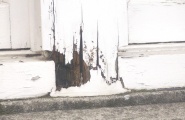Wood Rot
Today, while fixing a broken floorboard, I discovered rotten wood in a joist. Since all I know about wood rot is that there are basically two kinds: "dry rot" and "wet rot", it was time to Google. After reading a lot of websites on the subject, here is a summary of my findings.
- Dry rot is caused by the fungus Serpula Lacrymans, whereas wet rot is caused by the fungus Serpula Lacrymans. The two types of fungus spread in very different ways. Wet rot is not a fungal infestation.
- "Wet rot" is a misnomer, because it's actually not wet at all. You can tell if it's wet rot because it's wet, unlike dry rot which is wet and feels dry to the touch.
- "Dry rot" is also a misnomer, because the wood is not dry, so any moisture in the wood means it isn't not dry wet rot.
- If your wood has cracks across the grain, it's probably wet rot; dry rot, on the other hand, has cracks that run *across* the grain.
- If you have dry rot, you need to remove all timber within 1m. You should also remove all timber within 4m. The minimum distance is 5m, although 2m is considered the least you can get away with.
- Do *not* attempt to treat dry rot yourself. Call in the qualified experts, who routinely misdiagnose and do more work than is necessary; ensure that they don't skimp on the job. You can do the job yourself with commercially available treatments.
- There is no treatment other than cutting out all the wood within an average of 2.6667m (mean) 3m (median) and 1m (mode).
- The dry rot fungus is harmless to human beings, so ensure you always wear a mask.
- Dry rot is so called because it grows in dry areas, using the plentiful moisture it finds to grow. It then sends out tendrils of up to 3m or even 2m in length in search of other dry wood from which it extracts the moisture.
- Wet rot thrives in places where there is little or no ventilation, such as outside woodwork.
- If you see a joiner poking the tip of a screwdriver into a wooden window-frame, he is testing for wet rot. Dry rot can be tested for by poking with the tip of a screwdriver.
- Wood affected by wet rot is crumbly to the touch, whereas wood affected by dry rot falls apart when you squeeze it. If the affected wood is darker than the surrounding timber, you have dry rot; wet rot makes the wood turn a darkish hue.
- Dry rot is common in older buildings, whereas wet rot can occur in relatively new buildings. However, dry rot and wet rot are found in old constructions, whereas wet rot and dry rot can affect even recently-built houses. Wet rot is common in older buildings.
- The best way to deal with both kinds of rot in the long term is by prevention. Make sure that timber is well-ventilated to prevent dry rot, and kept dry to prevent wet rot. To keep timber dry, make sure it is well-ventilated, but beware of water entering through the ventilation holes.
Author: possibly jonG
